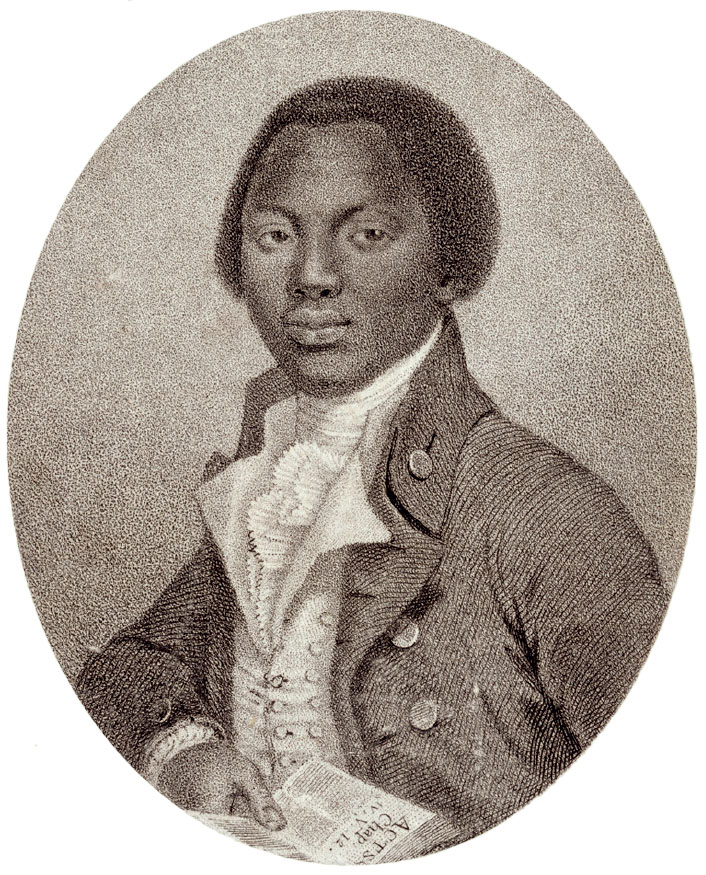Understanding World Societies:
Printed Page 600
INDIVIDUALS IN SOCIETY
Olaudah Equiano

The transatlantic slave trade was a mass movement involving millions of human beings. It was also the sum of individual lives spent partly or entirely in slavery. Most of those lives remain hidden to us. Olaudah Equiano (1745–
In his autobiography, The Interesting Narrative of the Life of Olaudah Equiano (1789), Equiano says that he was born in Benin (modern Nigeria) of Ibo ethnicity.* His father, one of the village elders (or chieftains), presided over a large household that included “many slaves,” prisoners captured in local wars. All people, slave and free, shared in the cultivation of family lands. One day, when all the adults were in the fields, two strange men and a woman broke into the family compound, kidnapped the eleven-
Equiano soon went to sea as a captain’s boy (servant), serving in the Royal Navy during the Seven Years’ War (see “The Seven Years’ War” in Chapter 22). On shore at Portsmouth, England, after one battle, Equiano was urged by his master to read, study, and learn basic mathematics. This education served him well, for after a voyage to the West Indies, his master sold him to a Philadelphia Quaker, Robert King, who was a rum and sugar merchant. Equiano worked as a clerk in King’s warehouse, as a longshoreman loading and unloading cargo ships, and at sea where he developed good navigational skills; King paid him for his work. Equiano became an entrepreneur himself, buying and selling small goods in the islands and mainland ports. Determined to buy his freedom, Equiano had amassed enough money by 1766, and King signed the deed of manumission. Equiano was twenty-
Equiano returned to London and used his remaining money to hire tutors to teach him hairdressing, mathematics, and how to play the French horn. When money was scarce, he found work as a merchant seaman, traveling to Portugal, Nice, Genoa, Naples, and Turkey. He even participated in an Arctic expedition.
Equiano’s Narrative reveals a complex and sophisticated man. He had a strong constitution and an equally strong character. His Christian faith undoubtedly sustained him. On the title page of his book, he cited a verse from Isaiah (12:2): “The Lord Jehovah is my strength and my song.” The very first thought that came to his mind the day he was freed was a passage from Psalm 126: “I glorified God in my heart, in whom I trusted.”
Equiano loathed the brutal slavery he saw in the West Indies and the vicious racism he experienced in the North American colonies. He respected the fairness of Robert King, admired British navigational and industrial technologies, and had many close white friends. He once described himself as “almost an Englishman.” He was also involved in the black communities in the West Indies and in London. Equiano’s Narrative is a well-
Olaudah Equiano’s Narrative, with its horrific descriptions of slavery, proved influential, and after its publication Equiano became active in the abolition movement. He spoke to large crowds in the industrial cities of Manchester and Birmingham in England, arguing that it was in the business interests of manufacturers to support abolition, as Africa was a huge, virtually untapped market for English cloth. Though he died in 1797, ten years before its passage, Equiano significantly advanced the abolitionist cause that led to the Slave Trade Act of 1807.
Source: Equiano’s Travels: The Interesting Narrative of the Life of Olaudah Equiano, ed. Paul Edwards (Portsmouth, N.H.: Heinemann, 1996).
QUESTIONS FOR ANALYSIS
- How typical was Olaudah Equiano’s life as a slave? How atypical?
- Describe Equiano’s culture and his sense of himself.

DOCUMENT PROJECT
What role did slave accounts play in antislavery activism? Read several first-